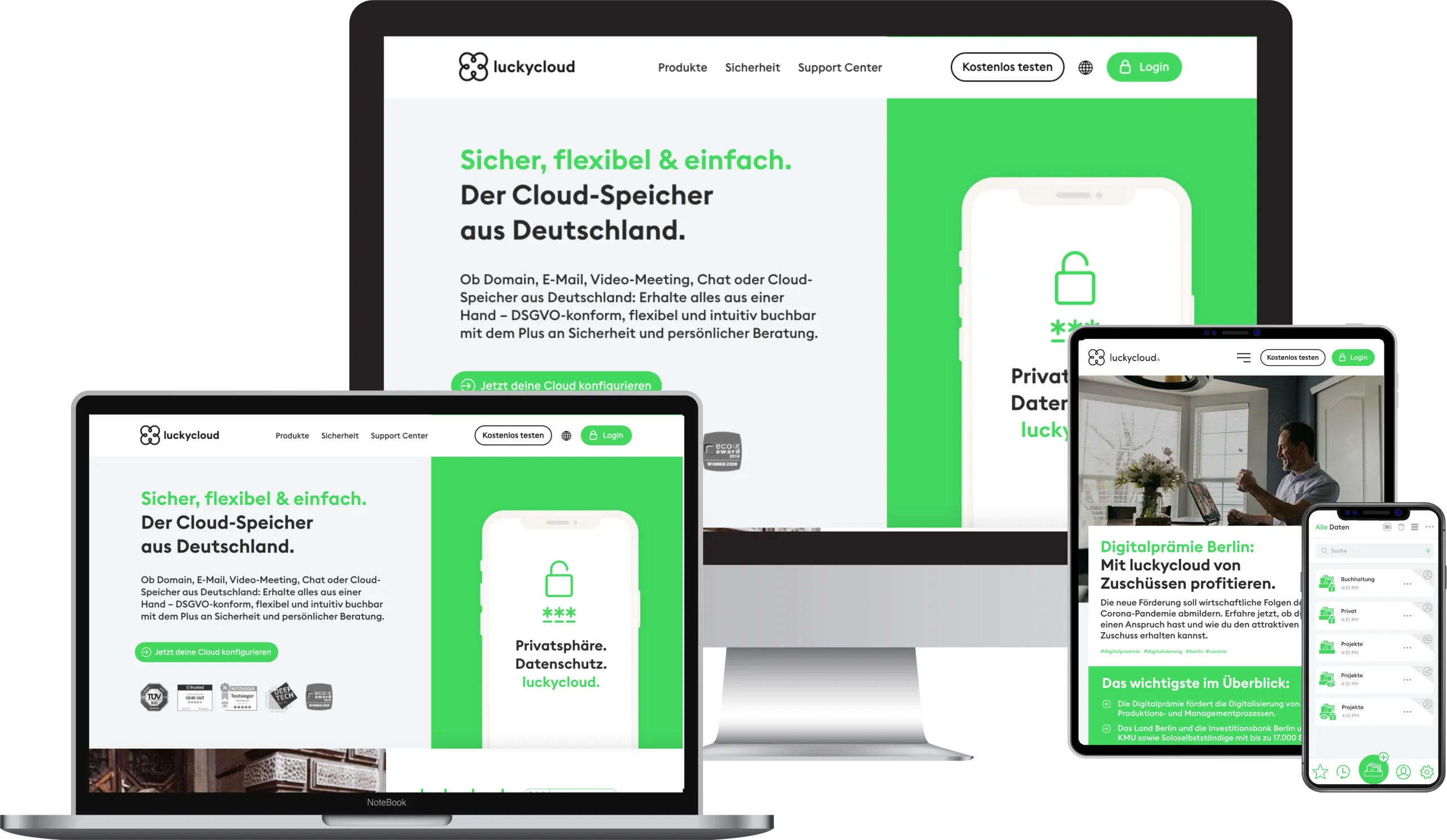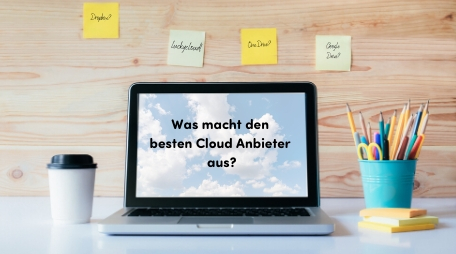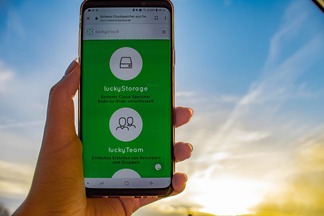Secure, flexible & simple
The cloud storage from Germany
Whether domain, email, video meeting, chat or cloud storage from Germany: get everything from a single source - DSGVO-compliant, flexible and intuitively bookable with the plus of security and personal advice.



Design and order or test your service now
Design your cloud now
Total costs / month
Which cloud solution? suits you?
Sync & Share
















































Management




























Security
























Look-and-feel
















Feature & Integration




































Service
















Support




















Design your cloud now
Total costs / month
Which cloud solution? suits you?
Sync & Share
















































Management




























Security
























Look-and-feel
















Feature & Integration




































Service
















Support




















Design your cloud now
Total costs / month
Which cloud solution? suits you?
Sync & Share
















































Management




























Security
























Look-and-feel
















Feature & Integration




































Service
















Support




















Design your cloud now
Total costs / month
Which cloud solution? suits you?
Sync & Share
















































Management




























Security
























Look-and-feel
















Feature & Integration




































Service
















Support




















Design your communication now
Total costs / month
Design your communication now
Total costs / month
Design your cloud now
Total costs / month

luckycloud
One
Our entry-level offer for you: cloud storage from Germany with maximum security and numerous upgrade options. With it, you have your data such as documents, pictures and music at your fingertips anytime and anywhere.
Learn more
luckycloud
Teams
Share and edit your data with other users in small teams - easily and intuitively. Whether at work with colleagues or privately with family and friends.
Learn more
luckycloud
Business
The secure business cloud storage from Germany for the highest security requirements. Benefit as a company with your teams from the luckycloud team advantages. More admin features are also waiting for you.t with family and friends.
Learn more
luckycloud
Enterprise (Plus)
The cloud with your own domain and individual branding for companies and resellers. Customize your cloud to your design or sell customized storage without luckycloud reference. Plus, get your own hardware and benefit from speed and maximum security.
Learn more
luckycloud
S3 storage
The archiving tool stores large amounts of data for you securely and flexibly. In addition, the extensible hybrid cloud enables application hosting for web application deployment, installation and management, software deployment, disaster recovery, and big data analytics.
Learn moreluckycloud can do even more
Flexible communication tools and services for secure collaboration. Add or easily deselect domains, mail, contact and calendar functions, meeting rooms, chats and connections to NAS servers (luckycloud box) at any time.
Design and order or test your service now
Design your cloud now
Total costs / month
Which cloud solution? suits you?
Sync & Share
















































Management




























Security
























Look-and-feel
















Feature & Integration




































Service
















Support




















Design your cloud now
Total costs / month
Which cloud solution? suits you?
Sync & Share
















































Management




























Security
























Look-and-feel
















Feature & Integration




































Service
















Support




















Design your cloud now
Total costs / month
Which cloud solution? suits you?
Sync & Share
















































Management




























Security
























Look-and-feel
















Feature & Integration




































Service
















Support




















Design your cloud now
Total costs / month
Which cloud solution? suits you?
Sync & Share
















































Management




























Security
























Look-and-feel
















Feature & Integration




































Service
















Support




















Design your communication now
Total costs / month
Design your communication now
Total costs / month
Design your cloud now
Total costs / month


secure cloud storage
from germany
With no other cloud provider are your files as secure as with luckycloud. Our cloud storage with its own data centers in Germany, triple encryption, open source software and zero-knowledge principle have the highest security standard. Only you have the key sovereignty over your data.


Data protection.
Data protection.
Data protection.
With luckycloud you act data protection compliant at any time and that easily in just a few steps. Data is processed in accordance with DSGVO and the Federal Data Protection Act.


Simple, intuitive and flexible.
Completely according to your rules!
Maximum performance, minimum effort: Our cloud services work very simply and intuitively. You benefit from numerous features and storage space of up to 500 TB without losing track of everything. Only charge for what you really need. Billing is monthly, quarterly, semi-annually, annually or biennially in advance - just as it suits you best.


100% cloud
100 % sustainable
Your cloud storage from luckycloud offers even more than the highest quality, state-of-the-art technology and user-friendliness. Because it is also 100 percent sustainable.
Your cloud storage from luckycloud offers even more than the highest quality, state-of-the-art technology and user-friendliness. Because it is also 100 percent sustainable.


There for you.
Personal and qualified.
luckycloud takes more time for you compared to other cloud providers. In the personal consultation, we find together the right cloud solution tailored to you. If you have any questions or problems, we are always there to help you with our expertise and experience.
Which cloud
suits you?
Whether 2, 5, 10 or 100 GB - you decide how much storage space you want to use. This reaches up to 500 TB and can be changed at any time. So you stay flexible and can adjust the account to your current needs. Find the right cloud solution for you in 3 easy steps!


luckycloud stands for data sovereignty.
Without ifs and buts!
We take data protection to the extreme and offer you highly available and individually scalable cloud services for your files:
- highest security levels and data sovereignty
- transparency through open source software
- data minimization and zero-knowledge cloud
- cloud storage with end-to-end encryption
- extensive privacy and control features
- Data processing according to EU-DSGVO and Federal Data Protection Act
- Flexibility and unlimited scalability
- Server locations in Germany for ultra-secure cloud storage

More than 10,000 companies
and countless users.
From small family businesses to large corporations from various industries.
Hybrid Cloud:
Free whitepaper
- Advantages at a glance
- Security and data recovery
- Hybrid cloud solutions in comparison
 Download now for free
Download now for free








































































